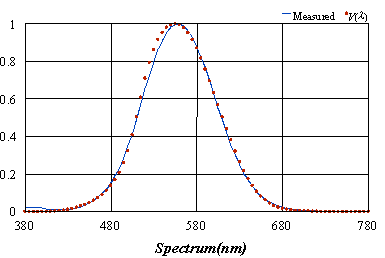



|
| Index | Products | Information | Contact | Order | Leavewords | Chinese Version |
|
All Digital Integral Photometric and Colorimetric Measurement Technology Abstract:All Digital Integral Photometric and Colorimetric Measurement Technology employs the digital photometric and colorimetric sensor to replace the traditional analogue sensor, employs the digital signal measurement system to replace the traditional analogue measurement system. It changes the traditional structure thoroughly. Keywords: all digital, analogue, photometric and colorimetric sensor Introduction: Photometric and colorimetric measurement instrumentation is one of the widely used instrumentation in the optical measurement field, which comes forth in 1970s. From initially up to now, all of them have the same characteristic, that is, the instrumentation is made of analog system. It can be indicated by the two primary parts: one is the X(l)Y(l)(V(l))Z(l) sensor, the other is the signal detecting system, the elements of both parts are analog components. In this paper, an all digital measurement technology is presented which is consist of digital X(l)Y(l)(V(l))Z(l) sensor and digital signal detecting system. Principle: Currently, we just discuss about the illuminance measurement as an example. The scheme of the traditional analog illuminancemeter and the all digital illuminancemeter is shown as Fig.1 and Fig.2.
Fig.1 scheme of the traditional analog illuminancemeter
Fig.2 scheme of the all digital illuminancemeter Comparison with two types of illuminancemeter The traditional illuminancemeter can be summarized as following: (1) Its output is a continuous signal (usually current) from the sensor, and it is an analog system. (2) Parts before the A/D converter in the signal detecting system are analog system, and the digital system after A/D converter. Therefore, some connatural defects can not be overcome based on such system. (1) Drift: The drift of the preamplifier is brought from the circumstance such as the change of temperature, moisture etc.. Therefore, a high accurate amplifier must depend on high quality components, that is, the quality of all the components in the signal channel must be insured to possess high linearity, low noise and low maladjustment etc.. Though all of them can be fulfilled, the drift can only be depressed, but impossible to be eliminated. (2) A/D converter error: The main A/D converter error is quantization error and sample noise. A 12 bit ADC chip is usually applied in the measurement system. Provided the converting error is 1 LSB, the accuracy is approximate 2.5*10-4 while the input signal attains its full range. However, the full range signal is difficult to be obtained for the varying light, hence the accuracy will usually be approximate 10-3. Moreover, the sample noise is also a trouble for the system. (3) Low anti-interference ability: Any analogue system can not hold high anti-interference ability. It is easy to be influenced by several factors, such as the fluctuation of the power supply. (4) Error from range-changing: Consideration on the wide input signal, though the sensor has large dynamic range (usually 106), if the ADC only can attain 10-4 (such as 12 bit ADC) sensitivity, a multi-range measurement structure is necessary. It will lead to range-changing error definitely. (5) Calibration: Calibration in the analog system is usually by adjusting some analog components, for example, adjusting the value of resistor to get appropriate gain. All these values will vary with time. In comparison with the current illuminancemeter, the merit of the all digital illuminancemeter is indicated as following: (1) No drift in measurement system: Since the digital V(l) sensor has been applied, the digital output signal can be easily connected to microprocessor directly, the preamplifier, other analog components and ADC are discarded. Consequently, the drift of measurement system is overcome, no drift will be in the digital system. (2) High accuracy: A high accurate measurement system has been developed, which is based on the microprocessor. It can achieve about 10-6 level usually which is more precise than 18 bit A/D converter. Moreover, no sample noise is in it. (3) High anti-interference ability: It is the inherence of the digital system compared with the analog system, and the stability of power supply is not required. (4) No error from range-changing: Since the digital V(l) sensor can attain more than 106 dynamic range, multi-range is not required, no error will be brought from range changing.
(5) Calibration: Such digital system contains internal RS232 interface, the calibration will be done by computer, and all the parameters will be fixed in the flash memory, they will not vary with time. The life-time of such memory is about 100 years. Performance The performance of all digital measurement instrumentation, for example: XYI-III all digital illuminancemeter:
Accuracy of relative spectral sensitivity of digital
V(l) sensor:
f1<5.5% (class B). Showed in Fig.3 |

Fig.3 Relative spectral sensitivity of the digital V(l) sensor(f 1=4.4%)
|
|Index | Products | Information | Contact | Order | Leavewords | |
|
Copyright: Hangzhou Xinye Optoelectronic Engineering Co.,Ltd. |